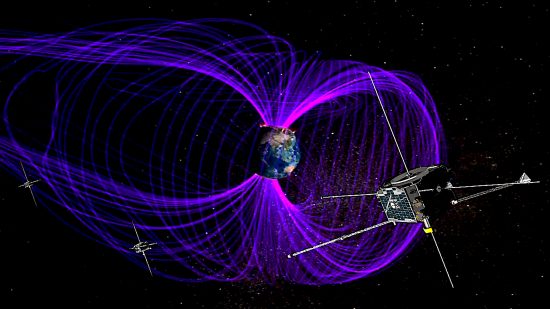
Feb 26, 2019
There is an electrical structure called a magnetotail extending away from Earth for millions of kilometers.
In 1966, the U.S. Navy satellite, TRIAD, recorded electromagnetic disturbances as it passed over Earth’s poles and through the Van Allen Radiation Belts. Those vertical electric currents that flow to Earth from the solar wind were named, “Birkeland currents” by Alex Dessler. The solar wind is captured in the magnetosphere, where it is collected in a plasma sheet within the magnetotail, and held together by Earth’s magnetic field.
Electromagnetic instabilities also occur when bright aurorae are seen. Norwegian scientist, Kristian Birkeland, along with a research team, discovered that electric charge from the Aurora Borealis flowed parallel to the auroral formation. Since electricity must flow in a circuit, and since the auroral glow seemed to be caused by events in space, Birkeland proposed that it came down from space at one end of the auroral arc and back out to space at the other.
Energetic ions stream down into the poles, exciting atmospheric molecules to the point where they emit various colors of light: red frequencies from oxygen at high altitudes, green from oxygen at lower altitudes, and blue light from nitrogen.
What does it mean when atoms are excited? When charged particles from the Sun strike atoms in atmospheric gases, electrons jump to higher-energy orbits, farther from the nucleus. When those electrons return to lower-energy orbits, they emit light. The aurorae are like neon lights in that regard: electricity excites gas within the glass tubes of neon signs.
Birkeland’s polar particle streams are now called auroral electrojets, and connect with electric circuits that follow Earth’s electromagnetic field into and away from the Arctic and Antarctic regions. Although NASA scientists acknowledge electric currents in their published papers, they persist in seeing them as “magnetic collision” effects in plasma.
Data from NASA’s THEMIS mission indicates that the Aurora Borealis sometimes creates intense bursts of light called substorms, a longstanding puzzle for astrophysicists. THEMIS scientists think that fast-moving substorms “crash into” large-scale, slow-moving aurorae, forming an auroral “knot” of plasma. When they collide there is an abrupt flash. THEMIS confirmed those plasma streams speeding toward Earth.
Light bursts from colliding aurorae are said to result from “magnetic reconnection”. The solar wind is supposed to “stretch” Earth’s electromagnetic field. When it “snaps back” the over-stretched magnetic field lines initiate a powerful explosion. As discussed in a previous Picture of the Day, how the energy is released, or how the process begins, are controversial subjects. Energy in nature cannot be destroyed, as the conservation of energy law states. When electricity powers a motor, it is converted to kinetic energy. When friction stops motion, its kinetic energy converts to heat. So called, “magnetic energy” is also thought to reappear in different forms. Some becomes heat, increasing the velocity of plasma ions and electrons. Some changes to visible light.
Space scientists are reversing cause (electric currents) and effect (magnetic fields). They downplay or deny the importance of the electrical processes and ignore the work of plasma pioneers like Kristian Birkeland. New discoveries are really confirming the experiments done by others more than 100 years ago.
Retired Professor of Electrical Engineering, Dr. Donald Scott’s admonitions about magnetic reconnection should always be kept in mind:
- Magnetic field lines are only convenient concepts, nothing more. They are not loci or contours of constant magnetic flux density (field strength). They just indicate the field’s direction. In regions where they are close together the field is stronger than where they are widely separated.
- Therefore, sketching magnetic field lines can help us visualize the shape and strength of magnetic fields. They can help us to sketch the net result (vector sum) if and when two or more fields interact (are superimposed on each other).
- We can only draw magnetic field lines (in cases not involving permanent ferromagnetic magnets) by considering the electric currents that create those fields.
- Magnetic lines of force do not actually exist in three-dimensional space anymore than lines of latitude or longitude do.
- If a field changes from one instant to another, we cannot use “streaming video” to watch a given line move and change shape. This is because we must redraw a complete set of lines at each instant. It isn’t the same line that has moved it is the field that has changed. The two sets of lines describe the field at those two different times.
- Magnetic lines of force do not move any more than lines of longitude do. A determined unwillingness to recognize this fact has led to the idea that lines can move toward each other, touch, merge, and then release energy. This last notion, if applied to circles of longitude that come together and “merge” at Earth’s poles, could be proposed as causing gravitational energy releases at those locations.
There is no such process as “magnetic merging” or “reconnection” of magnetic field lines in the real world.
Stephen Smith












